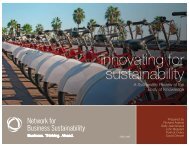embedding sustainability in organizational culture - Network for ...
embedding sustainability in organizational culture - Network for ...
embedding sustainability in organizational culture - Network for ...
You also want an ePaper? Increase the reach of your titles
YUMPU automatically turns print PDFs into web optimized ePapers that Google loves.
Chapter 1: 3: Introduction Foster<strong>in</strong>g Commitment<br />
27<br />
honest, and open communication policies cultivate and re<strong>in</strong><strong>for</strong>ce a <strong>culture</strong> of quality<br />
improvement.<br />
In<strong>for</strong>m<strong>in</strong>g is a practice that still requires academic test<strong>in</strong>g.<br />
assessment: proposed but not tested<br />
REpEat: Regularly and persistently engage <strong>in</strong> the activities and behaviours<br />
deemed important to the organization to ultimately embed these <strong>in</strong> the<br />
organization’s <strong>culture</strong><br />
• Communicate an important <strong>susta<strong>in</strong>ability</strong> message repeatedly,<br />
frequently and widely<br />
• Keep communication concise, but repeat it often<br />
• Use multiple media <strong>for</strong>mats to reach a wider audience, re<strong>in</strong><strong>for</strong>ce<br />
your message, and signal its importance<br />
• Repeat actions and behaviours that are desirable to the<br />
organization’s <strong>susta<strong>in</strong>ability</strong> vision<br />
A change <strong>in</strong> <strong>culture</strong> and the acceptance of new ideas takes time and persistent<br />
re<strong>in</strong><strong>for</strong>cement. S<strong>in</strong>ce employees learn at different rates, it makes sense to<br />
repeat a message to af<strong>for</strong>d everyone the time and mental space to acclimatize to<br />
fundamental changes. A manager <strong>in</strong> Harris and Crane’s (2002) study expla<strong>in</strong>ed<br />
how their <strong>organizational</strong> transition <strong>in</strong>volved a stage with many memos and other<br />
communications about <strong>susta<strong>in</strong>ability</strong>. Messages can be delivered by speeches from<br />
senior executives, discussions at staff meet<strong>in</strong>gs, <strong>in</strong>ternal memos, newsletters and<br />
<strong>in</strong>tranet systems. Us<strong>in</strong>g a variety of means helps build awareness of <strong>susta<strong>in</strong>ability</strong><br />
issues <strong>in</strong> employees and also improves their understand<strong>in</strong>g of the organization’s<br />
plans and values (Doppelt, 2003).<br />
An important aspect of repeat<strong>in</strong>g <strong>in</strong>volves know<strong>in</strong>g when to advance to the next<br />
stage of a message or change program. Employee surveys or other feedback tools<br />
can be used to understand how quickly a change has been adopted so that future<br />
communication and programs can be tailored appropriately (Doppelt, 2003).<br />
Employees should be permitted to ask the same <strong>susta<strong>in</strong>ability</strong> questions and address<br />
the same concerns repeatedly as they learn and discover. This will allow them to<br />
fully embrace the elements of the new shared <strong>culture</strong> (Wirtenberg et al., 2008).<br />
There were <strong>in</strong>dications of the importance of repeat<strong>in</strong>g among the empirical f<strong>in</strong>d<strong>in</strong>gs<br />
as well. One manager, describ<strong>in</strong>g the adoption of stakeholder relationship build<strong>in</strong>g<br />
behaviours amongst new employees, expla<strong>in</strong>ed how it took five to seven years of<br />
consistent actions and behaviour <strong>for</strong> <strong>susta<strong>in</strong>ability</strong> to seep <strong>in</strong>to <strong>organizational</strong><br />
<strong>culture</strong> (Sharma & Vredenburg, 1998). In another study, head office audits,<br />
orig<strong>in</strong>ally considered with suspicion by local management, became accepted as the<br />
norm after several years of repetition, as the managers developed trust and an open<br />
rapport with <strong>in</strong>spectors (Werre, 2003).<br />
From the safety literature, Cox, Jones and Coll<strong>in</strong>son (2006) found that constant,<br />
regular and rout<strong>in</strong>e rem<strong>in</strong>ders of the importance of safety were necessary to embed a<br />
safety <strong>culture</strong>.<br />
There is prelim<strong>in</strong>ary support <strong>for</strong> the value of repeat<strong>in</strong>g key <strong>susta<strong>in</strong>ability</strong> messages.<br />
More research is needed to understand this practice.<br />
assessment: Weakly supported<br />
follow up: Ensure <strong>susta<strong>in</strong>ability</strong> tasks are completed through monitor<strong>in</strong>g,<br />
review<strong>in</strong>g and enquir<strong>in</strong>g on the status of key tasks<br />
• Periodically evaluate your environmental results<br />
• Obta<strong>in</strong> employee feedback to understand their level of engagement<br />
• Review <strong>susta<strong>in</strong>ability</strong> per<strong>for</strong>mance results at regular status update<br />
meet<strong>in</strong>gs<br />
As an organization evolves, it is crucial to cont<strong>in</strong>ually assess and monitor its<br />
progress to ensure it is head<strong>in</strong>g <strong>in</strong> the right direction and employees are complet<strong>in</strong>g<br />
the tasks and goals assigned. This can be achieved via feedback loops, surveys,<br />
status updates, per<strong>for</strong>mance dashboards and committ<strong>in</strong>g managers to regular<br />
communication on their <strong>susta<strong>in</strong>ability</strong> deliverables (Dunphy et al., 2003; Ethical<br />
Corporation, 2009; NBS, 2010).<br />
From the safety literature, we learn that regular feedback from supervisors on<br />
whether employees’ behaviour was <strong>in</strong> l<strong>in</strong>e with safety improvement expectations,<br />
<strong>in</strong>clud<strong>in</strong>g <strong>in</strong> employees’ per<strong>for</strong>mance reviews, was crucial <strong>in</strong> mak<strong>in</strong>g these<br />
behaviours become habits (McCarthy & Blumenthal, 2006).<br />
Follow<strong>in</strong>g-up is a practice that has been proposed, but not yet tested empirically.<br />
assessment: proposed but not tested
















